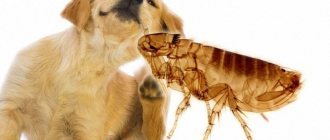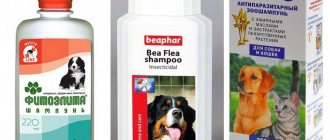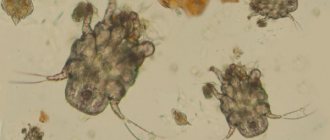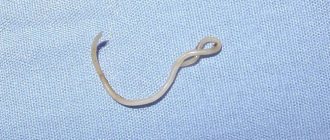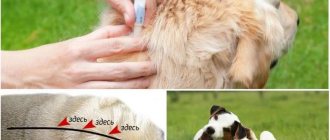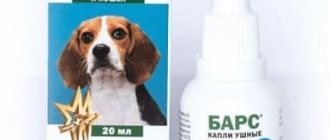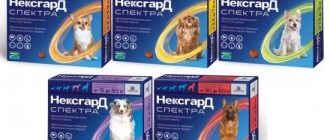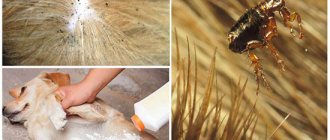Fleas are small blood-sucking parasites that cause a lot of trouble and inconvenience to both the animals themselves and their owners. The dog constantly itches and scratches itself until it bleeds; fleas can jump from animal fur onto the floor, climb on the floor, and walls. It is important to remember that dog fleas are not contagious to humans.
You can get rid of these annoying insects using pharmaceutical drugs or folk recipes. But will folk remedies be effective?
How to remove it using home methods?
These are time-tested techniques that will help clean your dog's fur. To make the procedure more effective, it is important to adhere to a number of rules.
- Before processing, it is necessary to comb out the animal's fur.
- Treat not only wool, but also bedding, carpets, and floor cracks. This will kill flea eggs and larvae.
- Place pine sawdust, lavender or wormwood on your dog's clean bedding. This will be an excellent prevention of re-infection.
- If there are other pets in the house, fleas should be treated for everyone at the same time.
There are many different recipes for preparing effective flea remedies. The simplest and safest thing is to use plants with a pungent odor:
- peppermint leaves;
- oregano;
- wormwood;
- tansy.
To prepare the product, 2-3 tbsp. of any raw material, pour 100-200 ml of boiling water and leave for 30 minutes. The herb wormwood or tansy can be additionally boiled over low heat for up to 10 minutes. Next, filter the solution, soak a cotton pad in it and wipe the animal’s fur. They leave it for 2-3 hours, then the animal needs to be bathed.
The next variation is the use of essential oils. Lavender, eucalyptus, tea tree, citronella, and cedar oil will be effective. The fighting mechanism is identical - the pungent smell repels parasites. You can mix the oils or use one: add 5-7 drops to shampoo or liquid soap, mix thoroughly and buy the dog.
Signs of bites
Flea bites are quite noticeable and unpleasant. It is very important to learn to recognize them in order to begin disinfection in time. After all, insects will not go away on their own: they multiply very quickly and begin to live in:
- cracks;
- carpets;
- sofas;
- bedding.
Here are some obvious signs that you have been bitten by a flea:
- At the moment of the bite, you will feel a prick on your skin, which is much more painful than a mosquito bite.
- Later, red dots may be seen on the skin. Sometimes the blisters swell and the skin around them turns red.
- The affected area is very itchy, causes a lot of trouble and constantly reminds you of itself.
- The bites are approximately 1–2 cm apart. But these are not straight paths, as happens if bedbugs live in the house.
- Insects usually bite legs, since their jumps do not exceed half a meter. But if they settled in the bed or jumped into it, they can bite the whole body.
Depending on the sensitivity of the skin and the characteristics of the human body, the marks after bites can be different: small, invisible or blurred, very large. But they will still disappear in a few days, so there is no need to be afraid.
What else should I treat to get rid of it?
| Name | Terms of use |
| Table or sea salt | The benefit of salt is that this substance destroys the chitinous membrane of insects The method of control is to bathe the dog in salt water.
|
| Camphor, table vinegar and cologne | This is a destructive mixture for any parasites. Combine the components in equal proportions. For better use, pour the resulting liquid into a spray bottle. Spray onto the animal's fur. Wait 10-15 minutes, do not let the animal lick itself. Then rinse well. |
| Boric acid | The fighting mechanism is that the substance disrupts the integrity of chitin, fleas die without their shell. The powder can be scattered around the house or diluted in water and sprayed onto the dog's fur. The product is completely safe for the animal. |
The most effective folk methods
Traditional methods used to control fleas are divided into two main categories:
- chemical (decoctions, infusions, drops, etc.);
- mechanical.
The feasibility of each of them is determined based on the individual characteristics of the animal: hair thickness, age, presence of damage to the skin, the pet’s reaction to the procedures, etc.
Chemical methods
All techniques for fighting insects that annoy dogs and cats with their bites are aimed at ensuring that fleas leave the pet’s body. However, you should know that animal fur is not the main home of parasites: they prefer secluded places (cracks in the floor, the back walls of furniture, etc.). They jump on animals only to get another portion of food. Therefore, the use of methods based on the use of various mixtures and solutions must be accompanied by disinfection throughout the apartment. Otherwise, the fleas will immediately return to their owner.
Decoction of wormwood with garlic
This method is based on the fact that the pungent odor of its components repels parasites. This is a very effective product, but it must be applied in such a way that the animal cannot lick it off, because this can cause digestive upset.
The solution is prepared as follows:
- Take a peeled head of garlic and grind it until mushy.
- Prepare a strong decoction of dry wormwood.
- Mix the broth with garlic thoroughly and apply to the coat.
For the first time, a small treatment is enough: this will allow you to determine whether the dog or cat is allergic to the components.
Garlic-yeast mixture
A folk remedy based on yeast and garlic has proven itself in the fight against fleas in cats and dogs, which allows you to safely and quickly alleviate the condition of your pet.
Its recipe:
- Chop the garlic.
- Infuse a small amount of yeast in warm water (use live yeast, not powdered);
- Combine garlic with infusion and apply to coat.
It is necessary to treat the animal with this solution at least 2 times a day. It is necessary to prepare a new infusion daily, since it loses its properties during storage.
Herbal decoction
To prepare this solution you need dry eucalyptus, tansy and wormwood. It should be prepared this way:
- Take all ingredients in equal proportions (1 tsp each).
- Add 150 ml of water and prepare a strong decoction.
- Treat your cat or dog with it.
The same solution can also be used to treat places where fleas may hide - this folk remedy, when used periodically, can completely expel insects from the house.
Herbal decoction
This folk remedy also involves the use of herbs with an unbearable odor for ectoparasites of cats and dogs.
- Take 1 tsp. dry lavender and pelargonium leaves.
- Pour 150 ml of water over them and boil over low heat for 5 minutes.
The advantage of this method is that the prepared broth does not lose its properties throughout the week if stored in the refrigerator.
Essential oils
They can be applied directly to the animal's fur or added to shampoos, or dripped in a small amount onto the collar.
Most often, in recipes for getting rid of fleas in cats or dogs, it is recommended to use rosemary, mint, cedar, eucalyptus, and citrus oils. To treat your pet, the oil must be diluted with water in a ratio of 3 drops per 150-200 ml.
Important: tea tree essential oil is prohibited for use on cats and dogs, since its smell provokes weakness and dizziness in animals, and if it enters the stomach it causes poisoning.
Mechanical methods
Such products are absolutely safe, so they are ideal to use when pets are young.
Combing
This folk method involves using a comb with densely set teeth. When combing, you can get rid of not only adults and larvae, but also their waste products, which often cause irritation and dermatitis in cats and dogs.
This remedy is not suitable for all pets: some of them do not like to be combed, so they begin to actively resist.
The main disadvantage is that this method requires long repetition to achieve complete elimination of ectoparasites.
Baking soda
The fur of a cat or dog can be treated with soda. It perfectly repels fleas, in addition, its small particles prevent the larvae from holding tightly to the fur. After using this folk remedy, the animal must be combed and the combed powder must be carefully removed. In the same way, you can treat the place where the animal sleeps.
The only disadvantage of this treatment is that the soda will spread throughout the house, but this problem is easily solved with a vacuum cleaner.
Sawdust and shavings
A completely safe method that involves placing pine sawdust in the place where your cat or dog constantly sleeps. Firstly, sawdust will serve as a mechanical means that removes fleas from wool, and secondly, insects really don’t like the smell of such wood.
The most effective is the simultaneous use of chemical and mechanical means, which, when used together, help quickly rid a cat or dog of parasites. It is also important to periodically check the animal's fur in order to be able to apply these methods at the initial stage of the disease.
You can also contact our site's staff veterinarian, who will respond to them as soon as possible in the comment box below.
Is it safe to treat with these methods?
The main advantage of traditional methods over pharmaceutical drugs is safety. They can be used for puppies, pregnant and lactating bitches, and sick individuals.
But, in comparison with chemical means, folk remedies are less effective. To achieve the result, several treatments will be needed. In the presence of severe infection, folk recipes will be ineffective.
Generalized advantages of folk remedies for fleas:
- variety of recipes and uses;
- availability;
- low price;
- admissibility of carrying out at home without visiting a veterinarian.
Among the disadvantages are painstakingness, duration and regularity of treatments (there is no guarantee for a certain period, like with drops or collars), a sharp unpleasant odor that eats into the wool. Also, in some cases, there is a risk of developing an allergic reaction to the plant or product.
Symptoms of infection and self-diagnosis
The bites of blood-sucking parasites cause irritation and severe itching of the skin in pets, in some cases accompanied by an allergic reaction. As a result, the animal begins to intensively lick the fur, and some of the fleas are removed. Therefore, it is sometimes difficult to understand that a cat or dog is suffering from fleas - the parasites jump on the animal only while feeding.
If you suspect something is wrong, you need to monitor your pet’s condition. If he is attacked, he begins to itch frequently and sharply, most of all in the area of the head and tail. The animal tries to bite insects, sometimes directly biting into itchy places on the body.
The skin in the affected areas becomes irritated and small red bumps and crusty areas may appear along the back and neck. The hair begins to fall out more intensively, and in advanced cases, bald patches appear. Fleas are carriers of helminths, so the presence of worms in an animal's feces indirectly indicates infection by insects.
Signs of fleas on an animal.
Having appeared in the house, parasites spread throughout its territory - they hide in carpets and other woolen products. The pet cannot hide from them anywhere, and its behavior changes. Owners of a cat or dog can recognize attacks by blood-sucking insects by the following signs:
- the animal avoids its usual sleeping place;
- becomes irritable and restless;
- shakes his head vigorously;
- suddenly jumps up;
- makes plaintive sounds or growls.
You can detect insects using a white cloth and a special comb, the teeth of which are arranged in such a way that fleas get stuck in them, or a comb with fine teeth. The pet is placed or laid on a cloth and its fur is combed from head to tail.
Increased attention is paid to areas on the inside of the paws, the back of the neck and at the base of the tail, where insects most often hide.
During the procedure, either fleas themselves are found in an infected animal - brown insects with a flattened body 2-4 mm long, or their eggs and excrement, which look like a mixture of white and black grains. A drop of water should be applied to the suspicious material. If it contains flea excrement, then when wet, the black grains will turn dark red because they contain blood cells. If there are no signs of infection, but the symptoms do not disappear, you should consult a veterinarian.
How to eradicate puppies?
Puppies under 2 months of age are prohibited from using any chemical preparations for fleas, since their body cannot yet withstand the strong influence of poisons and insecticides (risks poisoning and even death). Therefore, before the age of 2 months, the fight against fleas consists of bathing and regular combing.
Also during this period, the use of some folk remedies is allowed.
Reference! One option for eliminating fleas in puppies is to use citrus peels.
They can be placed around the house (their smell repels fleas) or rubbed into the animal's fur and then rinsed off. You can treat a small pet’s fur with a weak infusion of mint or lavender, or bathe it with a special shampoo with the addition of essential oils.
At the same time, carefully monitor that the puppy does not have an allergic reaction.
Prevention measures
Eliminating unwanted pests from your home is not a sign that they will not appear there again. It is also worth noting that not only animals, but also people can be carriers of insects; as a rule, a person can bring an unwanted parasite into his home through shoes or clothing.
That is why it is important to take a number of small precautions, namely:
- Keeping an eye on your pet while walking means that the dog or cat should not come into contact with stray animals.
- Every summer, buy a special collar for your pet, or treat the animal’s fur with special drops.
- Clean the apartment regularly to prevent large amounts of dust and debris from appearing.
- If insects appear in the apartment, eradicate them and check the animals for parasites.
By taking these precautions, you can significantly reduce the risk of pests in your home.
How to remove it from pregnant and lactating women?
Pregnant and lactating bitches are allowed to use almost all folk remedies. But you need to use caution (or better yet abstain for a while) from recipes containing aggressive ingredients.
- Compositions based on hydrogen peroxide. There is a risk of burns to the mucous membranes, and the substance also has a bad effect on the coat, it becomes lighter and duller.
- Hellebore water, since it is based on the poisonous herb hellebore and alcohol (dangerous, since the liquid can be absorbed into the skin).
- Ammonia and kerosene.
- Any compositions based on table vinegar.
Soap solutions for combing
The algorithm is quite simple: prepare a fresh solution, apply it to the dog’s fur, comb the dog, and rinse off the foam with running water. Parasites must be destroyed manually. For the solution, you will need to lather water with dog detergent and add cedarwood and lavender oils, plus:
- Eucalyptus or citronella oil is a good deterrent.
- Lemon, orange, mint oil - has a milder scent and is suitable for sensitive skin.
- Tea tree oil is an effective remedy against fleas and ticks. Cannot be used on cats!
The same mixtures of oils can be used to make a spray. The mixture is prepared based on water, alcohol and oil. The finished solution should have a noticeable odor, which will disappear with the evaporation of alcohol. Apply with a spray bottle (spray for plants) to the animal's fur and collar before a walk.
Review Reviews
Most dog owners note the safety and availability of traditional recipes. Below are the main extracts from real reviews on special sites for dog breeders.
- Veronica from Moscow says that regularly treating an animal's fur with a rich infusion of wormwood helped get rid of large colonies of fleas. The procedure had to be repeated 3 times with an interval of 4 days, but the result was the same as from pharmaceutical poisons, but there was less harm to the animal’s body.
- Victor from Rostov notes that folk products are suitable for small or medium-sized dogs. He is the owner of a German Shepherd, and using homemade recipes is labor-intensive and ineffective.
- Victoria from Orel highlights the benefits of essential oils. Every time you bathe your dog (Labrador), she applies a few drops of various fragrant oils to the pet’s fur. This serves as an excellent flea prevention: the oil kills eggs and larvae.
Are cat parasites transmitted to humans?
Many pet owners wonder whether cat parasites can spread to humans.
The cat flea is not very fond of human skin, although it bites when there is no other “victim” nearby. It will not live or reproduce on the body, since the temperature in humans is lower than that needed by the insect for metabolism and normal existence. And the cat’s temperature is approximately 38–39 °C, which is very comfortable for a flea. The difference in temperature is quite large, and we also have thicker skin than a pet.
Thus, the question of whether parasites are transmitted from cats to humans can be answered in the negative. But sometimes insects cause trouble: the bitten areas are very itchy.

